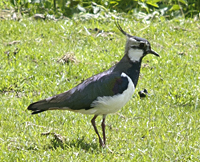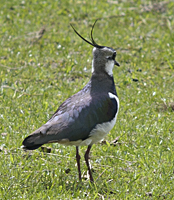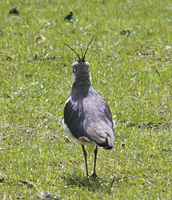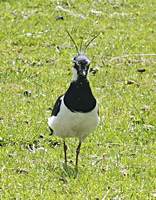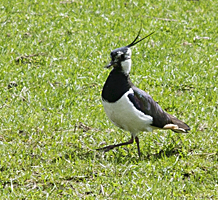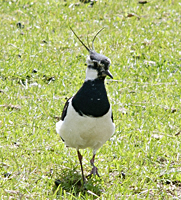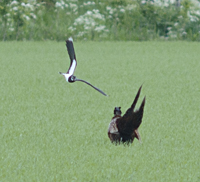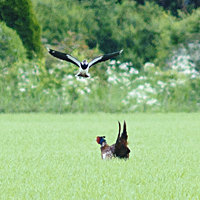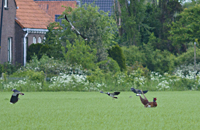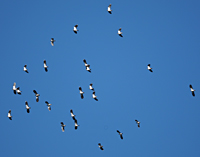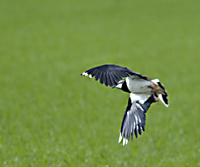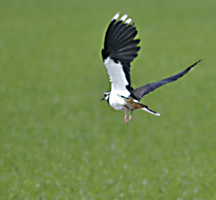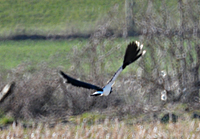[All pictures of garden wildlife on this page are thumbnails. Click on any thumbnail for a large format to be displayed.]
Gardensafari Northern Lapwing (Vanellus vanellus)
Click![]() here for the bird's sound.
here for the bird's sound.
Lapwings are quite common in Dutch countryside.
Although I have never seen this bird actually land on the ground in my garden, it flies over it very regularly. Since 70% of all European Northern Lapwings spend their summer in Holland, this could be the Dutch National Bird. With its long feathers on the back of its head, its contrasting black and white colours and the easy to recognize call "Qi-Vit", hence the Dutch name, it is one of the messengers of spring, as it early flies back from Africa (sometimes in March). Already in April it is depositing it's eggs in grasslands. The Northern Lapwing is also a daring bird. It will attack any bird that is a potential enemy such as all members of the crow family. Yet, nature is very much like politics. Once I saw a few Lapwings attack some bird of prey and I couldn't exactly see what bird it was. As soon as the attacker came back, a pair of Black Carrions came to rescue chasing the bird of prey and they even took the initiative over from the Lapwings. They then kept on chasing the poor bird of prey until it was far away and almost out of sight. That actually was an unexpected league, for crows will certainly eat the Lapwings eggs, given the chance.
The Northern Lapwing is easy to recognize: the tuft always gives it away, even from a great distance.
In the past in Holland there was a peculiar sport called 'finding the Lapwing's eggs'. It was especially practised in Frysia and other grassland provinces. The whole point was to be the first to find the first Lapwing's egg of the year. The very first egg of the country was then presented to the Queen of the Netherlands. Finder number two could present his egg to the Governor of the province, the rest were just local heroes who presented their egg to the burgomaster of his or her town. The tradition is now abandoned, except for certain areas. Now finding a Lapwing's egg is not easy at all. The bird doesn't make a real nest or something, it just deposits it's eggs in high grassland. That implies that certain risks have to be taken. In grassland there are real enemies, such as the Crows, but there are also creatures that are not feeding on the eggs, just treading the eggs to pieces: the horses, cows or farmers in the meadow. So the Lapwing developed a strategy that works on most dangers, enemies and duds alike. When someone is approaching the nest, one bird will remain on the nest, while the partner will land on the ground, far from the nest. This partner will then pretend to be hurt: he or she will run through the grass with one wing down and away from the nest of course. Then it will try to fly away and pretend that it can not. Now all creatures, enemies or duds, will immediately look at the wounded Lapwing and probably will follow the unsuccesful bird. But when they're very close the miracle happens: nothing is wrong with the bird and with some wingflapping it quickly flies away, shouting 'Qi-Vit'. Of course by then the bird has reached it goal: the potential danger is far away from the nest.
In May 2012 I witnessed several Lapwings attacking a male Common Pheasant (Phasianus colchicus) that invaded their breeding area close to my house. As you see in the above photos, the fight was spectacular to watch as the Lapwings kept on flying and diving onto the Pheasant for well over half an hour. Finally the Pheasant decided to give up and quickly left the meadow. Thus the much smaller Lapwings won from the Pheasant!
In early spring the Northern Lapwings come in flocks to the Netherlands. The sight of them marks the end of the winter in our part of the world.
This bird belongs to the family of Plovers (Charadriidae). It is also known under the name of Peewit or Green Plover. It is rare in my garden and can be seen in Holland march - september. The bird is 13" and weighs 200 grams. It lives in meadows and marshes mostly. It eats insects, worms and snails. Compared to the male, the female has a white throat. Nesting starts in march. The nest consists of a ditch in the ground, in which four eggs are deposited. The birds have to keep them warm until they hatch after some 28 days. The parents take care of their young for some six weeks!
Lapwings are good and elegant flyers that are very acrobatic in the air.
| Name of this bird in various other languages | ||||
| Dutch | German | French | Polish | Scientific |
| Kievit | Kiebitz | Vanneau huppé | Czajka | Vanellus vanellus |

© Copyright 1998-2024 gardensafari.net (Hania Berdys)

 English / engels
English / engels  Dutch / nederlands
Dutch / nederlands